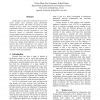Free Online Productivity Tools
i2Speak
i2Symbol
i2OCR
iTex2Img
iWeb2Print
iWeb2Shot
i2Type
iPdf2Split
iPdf2Merge
i2Bopomofo
i2Arabic
i2Style
i2Image
i2PDF
iLatex2Rtf
Sci2ools
95
Voted
IV
2003
IEEE
2003
IEEE
A Model of Synchronous Collaborative Information Visualization
In this paper we describe a model of the process by which people solve problems using information visualization systems. The model was based on video analysis of forty dyads who performed information visualization tasks in an experiment. We examined the following variables: focused questions vs. free data discovery, remote vs. collocated collaboration, and systems judged to have high and low transparency. The model describes the stages of reasoning and generating solutions with visual data. We found the model to be fairly robust across task type, collaborative setting, and system type, though subtle differences were found. We propose that system transparency can support some stages of the process, and that support is needed in the last stage to help users translate their findings from visual to written representations.
Related Content
| Added | 04 Jul 2010 |
| Updated | 04 Jul 2010 |
| Type | Conference |
| Year | 2003 |
| Where | IV |
| Authors | Gloria Mark, Keri Carpenter, Alfred Kobsa |
Comments (0)

